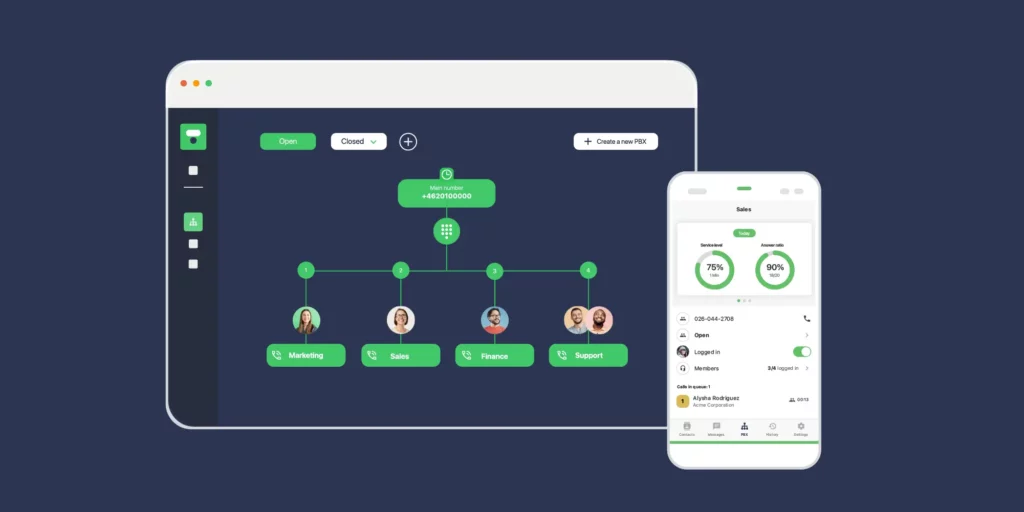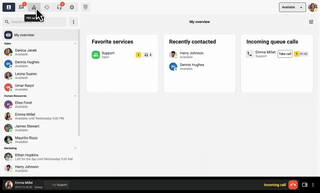One thing is for sure – no one likes to be on hold. To improve customer satisfaction and shorten queues, reviewing your queuing system can help you reduce both actual and perceived waiting times, thereby improving the overall customer experience.
Do you also get annoyed waiting in a phone queue? You are not alone. Forbes reports that 57% of people feel that waiting on hold for a long time creates a negative customer experience. For a call center queue system to work as well as possible, you need the right software, trained agents and guidelines on how to handle the call center.
A telephone exchange, also known as a business exchange or PBX (Private Branch Exchange), is a company’s own communication network that allows the caller to switch between different menu options and select extensions. A cloud PBX is the cloud-based version that integrates traditional telephony with IP telephony, CRM and customer service, bringing a range of benefits to your telephony – and therefore your queues.
Do you have the right number of switches and agents?
While everyone would prefer to arrive straight away without having to wait in line at all, the most important thing is to be connected to the right person once they arrive. To be as efficient and economical as possible, you need to have the right number of exchanges. So take a look at how busy your switchboard is at the moment. If callers often have to wait for a long time, it’s time to scale up to more exchanges.
When it’s busy, it’s also extra important that your agents are placed in the right queues. You need to constantly monitor where demand is highest. If a queue is busy, you should move agents to that queue to meet the higher demand.
IVR (voice response) for a better customer experience
A common annoyance is being transferred to the wrong person in the switchboard who cannot solve their problem. By using interactive voice response (IVR ) in the switchboard, which gives the caller different options, you can eliminate the risk of the caller being misdirected. This could be a voice telling the caller what the company’s phone hours are or what choices the caller can make depending on the case. You can even offer options so that the caller doesn’t even have to speak to an agent, but gets the information directly.
With an IVR function, employees can also set up personal messages, for example, if they are on vacation, in a meeting or have left for the day. This lets callers know immediately when it’s best to try again if they don’t get through straight away.
Use the customer information you already have available
If your CRM is integrated with your telephony, not only will your support be more efficient and profitable, but your customers will be much happier. As soon as an existing customer calls in, the agent who receives the call gets the person’s details directly. The agent can see all the information about the customer, leading to more effective help. They can see the customer number and social security number, but also what the customer has bought in the past, and whether there are any previous cases registered.
Using the information you have about your customers, in your CRM or similar system, you can connect calls to the right queue. This may involve language selection and connecting people to an agent who speaks their language. You may also have divided your customers into different groups, with certain loyal customers having VIP status and being given priority or being assigned to a specific VIP queue.
Review statistics and data
Another important proactive element is to study the previous year’s occupancy and learn from the switchboard statistics. In the queue history, you can see which phone numbers were called, the time the calls arrived and their duration. You can also see how many calls were queued, how long callers were kept waiting and which agents they spoke to. Then review which periods are the busiest and where you should allocate the most agents.
Also, don’t forget to measure first-contact resolution, i.e. how the agents in the contact center are at solving customer problems on the first try.
On-hook waiting – let customers be called
At Telavox, we offer an additional service with extended statistics and queue functions that we call on-hook waiting or callback. This means that a caller who is placed in a queue can choose to leave their phone number and be called instead. This is an incredibly valuable feature today as many people are short of time and do not have to sit and wait on the phone. Read more about how to activate on-hook waiting and our additional service Call Center Pro.
Summary: Benefits of a smart queuing system
With well thought-out queuing procedures, the direct impact is of course happier customers who get help faster. Agents can work more efficiently and have a smoother workday. In addition, this in turn can result in a reduction in your time-to-resolution, i.e. the time it takes for agents to resolve cases.


